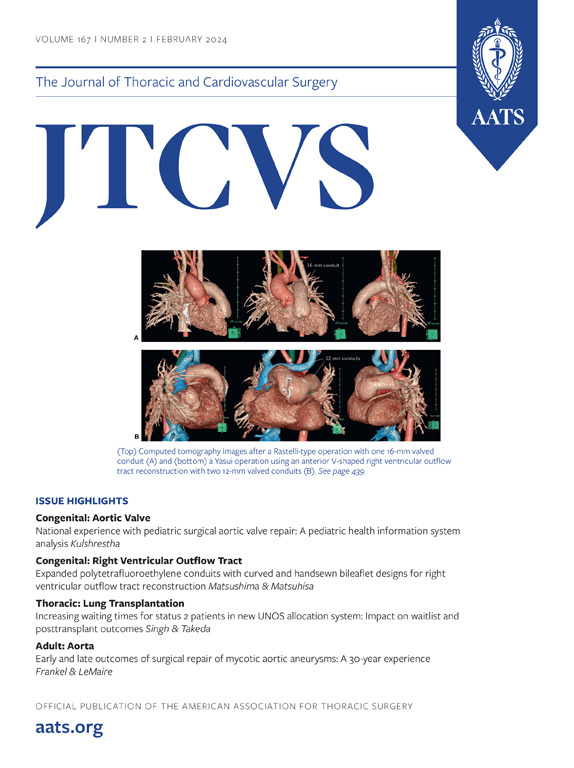Do nonfatal events during the first 5 years after coronary artery bypass surgery influence 10 year outcomes?
IF 4.4
1区 医学
Q1 CARDIAC & CARDIOVASCULAR SYSTEMS
Journal of Thoracic and Cardiovascular Surgery
Pub Date : 2024-09-25
DOI:10.1016/j.jtcvs.2024.09.034
引用次数: 0
Abstract
Objective
Few have examined the influence of early adverse events after coronary artery bypass grafting (CABG) on long-term survival. We sought to determine if the occurrence of nonfatal major adverse cardiac and cerebrovascular events (MACCE) during the first 5 years after CABG influences survival and adverse events at 10 years.
Methods
All patients who underwent isolated CABG from 1990 to 2014 at a single center in Ontario, Canada, were included. Primary end point was all-cause mortality. The secondary end point of interest was MACCE, a composite of mortality, nonfatal myocardial infarction, stroke, and repeat revascularization.
Results
A total of 20,444 cases of elective primary isolated CABG were identified as being alive at 5 years, with 11% of patients developing nonfatal MACCE within the first 5 years after CABG (MACCE group) and the remaining 89% were alive without a MACCE event at 5 years (non-MACCE group). Following propensity score matching, 2167 patient-pairs were formed. Among the MACCE group, 972 out of 2167 (44.9%) developed a myocardial infarction, 519 out of 2167 (24.0%) had a stroke, and 946 out of 2167 (43.7%) required a repeat revascularization within the first 5 years after CABG. Non-MACCE was associated with better overall survival (hazard ratio, 1.42; 95% CI, 1.25-1.63; P < .01) and freedom from MACCE (hazard ratio, 1.61; 95% CI, 1.45-1.79; P < .01) up to 10 years after CABG compared with MACCE cases.
Conclusions
Patients who experienced nonfatal MACCE during the first 5 years after CABG experienced worse survival and more MACCE at 10 years. Prevention of major adverse events during the first 5 years after surgical revascularization may be an important strategy to improve late outcomes.
CABG 术后头 5 年的非致命性 MACCE 会影响 10 年的预后吗?
目的:很少有人研究冠状动脉旁路移植术(CABG)后早期不良事件对长期生存的影响。我们试图确定冠状动脉旁路移植术后前 5 年内发生的非致命性重大心脏和脑血管不良事件(MACCE)是否会影响 10 年后的生存率和不良事件:方法: 纳入1990-2014年期间在加拿大安大略省一家中心接受孤立CABG手术的所有患者。主要终点为全因死亡率。次要终点是MACCE,即死亡率、非致命性心肌梗死、中风和重复血管再通的复合终点。结果:20444例选择性原发性孤立CABG患者在5年后存活,其中11%的患者在CABG术后5年内发生非致命性MACCE(MACCE组),其余89%的患者在5年后未发生MACCE事件(非MACCE组)。经过倾向评分匹配后,形成了 2,167 对患者。在 MACCE 组中,有 972 人/2,167 人(44.9%)发生了心肌梗死,519 人/2,167 人(24.0%)发生了中风,946 人/2,167 人(43.7%)在 CABG 术后 5 年内需要再次进行血管重建。非 MACCE 与较好的总生存率相关(HR 1.42 [95% 置信区间 (CI) 1.25-1.63],p结论:在接受心血管造影术后的前 5 年中发生过非致命性 MACCE 的患者在 10 年后的生存率更低,发生的 MACCE 更多。在手术血运重建后的前五年预防重大不良事件可能是改善后期预后的重要策略。
本文章由计算机程序翻译,如有差异,请以英文原文为准。
求助全文
约1分钟内获得全文
求助全文
来源期刊
CiteScore
11.20
自引率
10.00%
发文量
1079
审稿时长
68 days
期刊介绍:
The Journal of Thoracic and Cardiovascular Surgery presents original, peer-reviewed articles on diseases of the heart, great vessels, lungs and thorax with emphasis on surgical interventions. An official publication of The American Association for Thoracic Surgery and The Western Thoracic Surgical Association, the Journal focuses on techniques and developments in acquired cardiac surgery, congenital cardiac repair, thoracic procedures, heart and lung transplantation, mechanical circulatory support and other procedures.

 求助内容:
求助内容: 应助结果提醒方式:
应助结果提醒方式:


